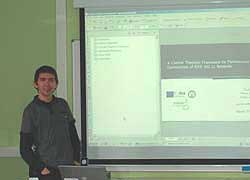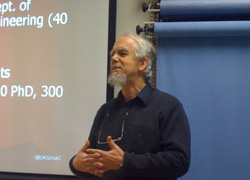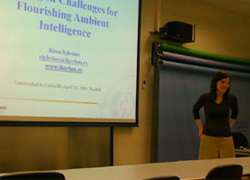IMDEA Networks

Archives: Events
A Control Theoretic Framework for Performance Optimization of IEEE 802.11 Networks
More information about Paul Patras The seminar will be conducted in English
Read more arrow_right_altFrom Networking Research to Hapto-Virtual Multimedia Communications
Multimedia Communications, involving traditional “media” such as audio, video, text, 2D graphics, have become parts of everyday e-life. New digital media, such as Virtual Reality and Haptics, have now added new dimensions to multimedia tele-collaboration. This presentation will introduce basic issues on Distributed and Collaborative Virtual Environments, where the feeling of “touch” (haptics) and its transmission over networks is becoming essential. Various applications will be described ranging from industrial training to e-commerce to medical education, and the current research at the DISCOVER research lab, Univ. of Ottawa will be outlined.
Read more arrow_right_altClubADSL
"ADSL is becoming the standard form of residential and small-business broadband access to the Internet due, primarily, to its low deployment cost. These ADSL residential lines are often deployed with Access Points (AP) that provide wireless connectivity. While the ADSL technology has showed evident limits in terms of capacity, the short-range wireless communication can guarantee a similar or higher capacity. Even more important, it is often possible for a residential wireless client to be in range of several other APs belonging to nearby neighbors with ADSL connections. We introduce ClubADSL, a prototype wireless station that can connect to several multi-frequency APs in range and aggregate their available ADSL bandwidth. ClubADSL achieves a fair bandwidth among the concurrent stations and minimizes the impact of end-to-end latency on the system performance. We show the feasibility of such a system in seamlessly transmitting TCP traffic, and validate its experimental implementation over commodity hardware in controlled scenarios."
Read more arrow_right_altBetting on Challenges for Flourishing Ambient Intelligence
This talk will present a brief overview of systems, technologies and applications that are part of Ambient Intelligence (AmI). It is also the purpose of this talk to bring together researchers for inspiring innovation in the evolution of AmI and for answering the question: What are the challenges we need to bet on?
Read more arrow_right_altMultipath TCP
Normal TCP/IP operation is for the routing system to select a best path that remains stable for some time, and for TCP to adjust to the properties of this path to optimize throughput. A multipath TCP would be able to either use capacity on multiple paths, or dynamically find the best performing path, and therefore reach higher throughput. By adapting to the properties of several paths through the usual congestion control algorithms, a multipath TCP shifts its traffic to less congested paths, leaving more capacity available for traffic that can't move to another path on more congested paths. And when a path fails, this can be detected and worked around by TCP much more quickly than by waiting for the routing system to repair the failure.
Read more arrow_right_altWireless Mesh Networks: QuRiNet Testbed and Related Research
Wireless mesh networks are becoming popular alternatives to wireless LANs and for cost-effective use in varied application environments. There are several technical challenges that must be addressed for mesh networking to be as effective as any other form of broadband networking. Much of these challenges relate to multi-hop wireless communication and limited capacity. The goal of this informal presentation is to facilitate further discussions on these challenges.
Read more arrow_right_altISP-friendly Swarm-based P2P streaming
Existing Swarm-based Peer-to-Peer Streaming (SPS) applications rely on a randomly connected overlays among peers, which tend to generate a significant amount of costly inter-ISP traffic. To reduce such traffic, localization of overlay connectivity within each ISP has received a great deal of attention as a promising approach for reducing the volume of inter-ISP traffic.
Read more arrow_right_alt
Design and evaluation of interconnecting structured peer-to-peer networks with a hierarchical topology
This talk gives an overview on how different overlay networks can share information among them and some recent results based on an implementation tested on an emulation environment are given.
Read more arrow_right_altMonitoring and Managing the Quality of Service in Structured Peer-to-Peer Systems
The peer-to-peer paradigm shows the potential to provide the same functionality like client/server based systems, but with much lower costs.
One substantial limitation of p2p systems are missing guarantees on the quality of service, as the whole infrastructure is based on unreliable peers. In order to control the quality of peer-to-peer systems, monitoring and management mechanisms need to be applied. Both tasks are challenging in large-scale networks with autonomous, unreliable nodes.
Read more arrow_right_altDeep Diving into BitTorrent Locality
A substantial amount of work has recently gone into localizing BitTorrent traffic within an ISP in order to avoid excessive and often times unnecessary transit costs. Several architectures and systems have been proposed and the initial results from specific ISPs and a few torrents have been encouraging. In this work we attempt to deepen and scale our understanding of locality and its potential. Looking at specific ISPs, we consider tens of thousands of concurrent torrents, and thus capture ISP-wide implications that cannot be appreciated by looking at only a handful of torrents. Secondly, we go beyond individual case studies and present results for the top 100 ISPs in terms of number of users represented in our dataset of up to 40K torrents involving more than 3.9M concurrent peers and more than 20M in the course of a day spread in 11K ASes. We develop scalable methodologies hat permit us to process this huge dataset and answer questions such as: What is the minimum and the maximum transit traffic reduction across hundreds of ISPs? What are the win-win boundaries for ISPs and their users? What is the maximum amount of transit traffic that can be localized without requiring fine-grained control of inter-AS overlay connections? What is the impact to transit traffic from upgrades of residential broadband speeds?
Read more arrow_right_alt











Recent Comments